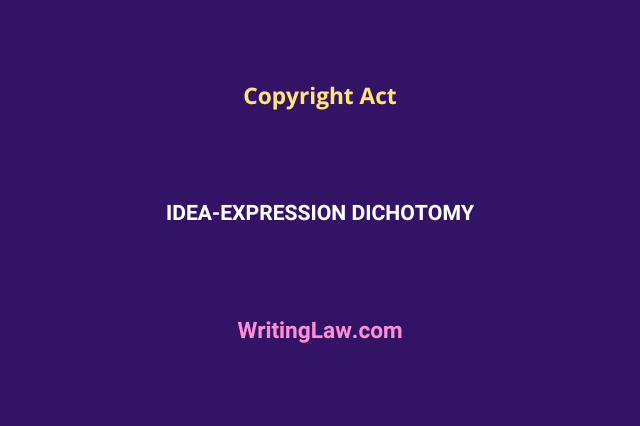
The phrase “idea-expression dichotomy” states that while ideas are not protected by copyright law, the expressions of those ideas are. In other words, an idea won’t be covered by copyright law if it isn’t transformed into a particular form, like designs or a specific arrangement of words.
Article 9(2) of the Trade-Related Aspects of Intellectual Property Rights (TRIPS) provides for this idea, stating that “Copyright protection shall extend to expressions and not to ideas, procedures, methods of operation, or mathematical concepts as such.”
History and Purpose
The first known case of the idea-expression dichotomy is Baker vs Selden, a case that the US Supreme Court heard. The “idea-expression dichotomy” was reinforced by this decision, which established a crucial premise in modern copyright law.
According to this legal precedent, an idea’s precise manifestation or embodiment is the only part protected by copyright laws, not the idea itself.
Examples of Idea-Expression Dichotomy
Example 1: For clarity, let’s look at an example of the famous movie 3 Idiots. It is a comedy-drama movie examining the pressures placed on the Indian educational system. It tells the tale of three friends who defy social standards and follow their passions despite obstacles.
Now, this does not imply that no films may be made using the notion of the challenges of the Indian educational system as their basis. While the concept may be the same, how it is represented must differ; if the expression is the same, then copyright infringement will result.
Example 2: Harshad Mehta’s story inspired Hansal Mehta’s TV series Scam 1992, which starred Pratik Gandhi. Another movie, The Big Bull, directed by Kookie Gulati and starring Abhishek Bachchan, was also based on a tale by Harshad Mehta. These films are based on the same story or concept but have distinct expressions. Thus, both of them will be granted copyright over their works.
It would have established a monopoly and prevented anybody else from making a movie based on Harshad Mehta’s narrative if we had granted copyright to the movie’s idea, or in this case, Harshad Mehta’s narrative. Therefore, ideas are not protected by copyright.
Example 3: Consider a situation where two authors separately create narratives about a young hero with magical abilities attending a school for wizards to demonstrate this paradox. The concept of a young hero enrolling in a wizarding school is not protected by copyright, but each writer’s unique presentation of the idea, including the characters, plots, dialogue, and other original components, may be.
The difference is made because ideas are viewed as being more abstract and having the potential for autonomous development by several people. By monopolising essential ideas, copyright protection for ideas will impede creativity and restrict societal advancement.
On the other hand, copyright protection is given to a specific manifestation of an idea to recognise and reward artists who devote their time and talent to shaping such ideas.
The concept of the idea-expression dichotomy has to emphasise the level of abstraction as a critical component. The fundamental concepts are not protected by copyright law; only their specific manifestation is. The degree of abstraction describes how much a phrase resembles the idea it conveys.
Copyright protection is less likely to be granted to highly abstract expressions, such as general concepts or themes, as this preserves the free exchange of basic ideas and prevents limitations on creativity and innovation.
However, as the expression becomes more specific and tangible, incorporating originality, creativity, and a personal touch, it becomes more eligible for copyright protection.
Think of a well-known landscape painting as an illustration. Since a landscape is a basic idea, it cannot be protected by copyright. The painting’s distinctive and original composition of colours, brushstrokes, and other aesthetic components is nonetheless covered by copyright. This differentiation guarantees that artists are compensated for their unique creativeness and aptitude for idea expression.
The idea of the contradiction between ideas and ways of expressing them also supports the accessibility of works in the public domain. Public domain works are open to anybody and are not covered by copyright laws. By being exempt from copyright protection, ideas can continue to be shared, expanded upon, and utilised to inspire new creative works in the public domain.
Conclusion
The distinction between an idea and its expression can occasionally be challenging to draw; thus, courts may need to consider the specifics of a case to decide whether copyright protection applies.
In a nutshell, the idea-expression dichotomy concept promotes innovation and aids in avoiding monopolies. Additionally, it enables the expression of the same ideas in a variety of methods that are innovative in and of themselves. It distinguishes between the protection of ideas and the protection of the expression of those ideas. It helps to create a balance between encouraging innovation and creativity and enabling the free exchange of ideas and information in society.
- What Is Misappropriation of Trade Secrets and Its Defences? - 15th May 2024
- 7 Important Types of Mediation Briefly Defined - 14th May 2024
- Whirlpool India vs Videocon Industries – Case Explained - 13th May 2024







